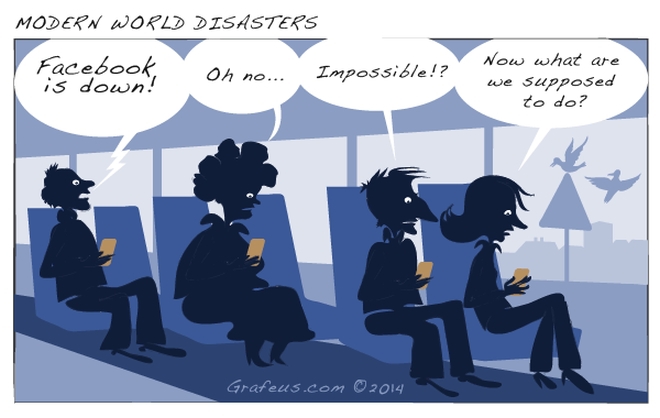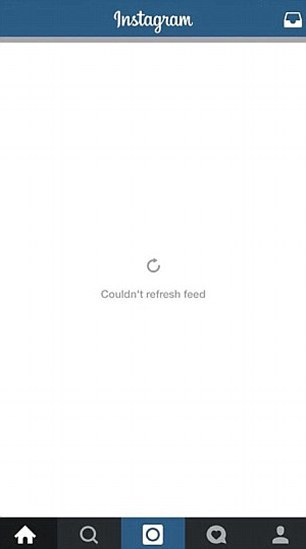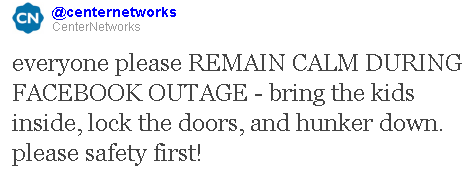Disabling Facebook affects sites that use their authentication system.
Facebook, Instagram, and other well-known sites that use a Facebook account to sign in have suffered from a downtime of 45 minutes to an hour on Monday evening PST.

Dynatrace analysis showed that more than 7,500 sites that use Facebook as a third-party service were affected by the disconnection. A group called Lizard Squad claimed responsibility for launching a distributed denial of service (DDoS) attack, which resulted in the inactivity or slowing down of many sites using the Facebook authentication system.

')
Who are Lizard Squad? This is a group of hackers that is strikingly similar to the online anarchist group Anonymous. Lizard Squad strives to cause havoc on the Internet “for laughter” and call themselves “the next generation of Grinch”, after the name of a child character who hates Christmas. They often use Twitter to boast of forthcoming attacks. According to some reports, the group works mainly from Russia, but, more likely, it brings together hackers from around the world. You should be familiar with Lizard Squad after the attack on the Sony Playstation video game servers in December. In addition, the group claimed responsibility for hacking a Malaysia Airlines website.
Facebook has denied Lizard Squad claims. The company called the reason for the shutdown configuration change. "It was not the result of a third-party attack, everything happened after we made changes to the system configuration," said a spokeswoman for The Wall Street Journal Facebook.
An example of Internet services that suffered from Facebook disconnection is the Tinder dating site and the AOL Instant Messenger instant messaging program (AIM). Facebook owned Instagram didn't work. Facebook transferred the Instagram infrastructure from the Amazon web service to its own data centers after it acquired the company.


http://youtu.be/wfESNYnKj1Y
Twitter was extremely active at the time, including the Lizard Squad:



A Facebook spokeswoman said: “We quickly solved the problem and both services returned to 100% availability for all.”
Facebook Vice President of Engineering, Jay Parikh, tweeted something about how difficult it was to service more than 1.4 billion people, but later deleted the message. His team spends a lot of time and resources on architecture fault tolerance and tests. One of the tests includes a complete disabling of the data center to see if the services will remain active, and imagine if they did it.
The biggest Facebook outage happened in September 2010. The site was unavailable for more than two and a half hours, and the outage was said to be the worst in history. To fix the problem, then the site was restarted. The Facebook team apologized to the users, saying that it was a good lesson, and they will do everything possible so that this does not happen again. The last Facebook shutdown was in September 2014, then it lasted only 15 minutes, but it was the third since the beginning of the summer (two more occurred in June and August last year) and led to a mass of disturbances on Twitter.

Dynatrace analysis showed that more than 7,500 sites that use Facebook as a third-party service were affected by the disconnection. A group called Lizard Squad claimed responsibility for launching a distributed denial of service (DDoS) attack, which resulted in the inactivity or slowing down of many sites using the Facebook authentication system.

')
Who are Lizard Squad? This is a group of hackers that is strikingly similar to the online anarchist group Anonymous. Lizard Squad strives to cause havoc on the Internet “for laughter” and call themselves “the next generation of Grinch”, after the name of a child character who hates Christmas. They often use Twitter to boast of forthcoming attacks. According to some reports, the group works mainly from Russia, but, more likely, it brings together hackers from around the world. You should be familiar with Lizard Squad after the attack on the Sony Playstation video game servers in December. In addition, the group claimed responsibility for hacking a Malaysia Airlines website.
Facebook has denied Lizard Squad claims. The company called the reason for the shutdown configuration change. "It was not the result of a third-party attack, everything happened after we made changes to the system configuration," said a spokeswoman for The Wall Street Journal Facebook.
An example of Internet services that suffered from Facebook disconnection is the Tinder dating site and the AOL Instant Messenger instant messaging program (AIM). Facebook owned Instagram didn't work. Facebook transferred the Instagram infrastructure from the Amazon web service to its own data centers after it acquired the company.


http://youtu.be/wfESNYnKj1Y
Twitter was extremely active at the time, including the Lizard Squad:



A Facebook spokeswoman said: “We quickly solved the problem and both services returned to 100% availability for all.”
Facebook Vice President of Engineering, Jay Parikh, tweeted something about how difficult it was to service more than 1.4 billion people, but later deleted the message. His team spends a lot of time and resources on architecture fault tolerance and tests. One of the tests includes a complete disabling of the data center to see if the services will remain active, and imagine if they did it.
The biggest Facebook outage happened in September 2010. The site was unavailable for more than two and a half hours, and the outage was said to be the worst in history. To fix the problem, then the site was restarted. The Facebook team apologized to the users, saying that it was a good lesson, and they will do everything possible so that this does not happen again. The last Facebook shutdown was in September 2014, then it lasted only 15 minutes, but it was the third since the beginning of the summer (two more occurred in June and August last year) and led to a mass of disturbances on Twitter.
Source: https://habr.com/ru/post/249867/
All Articles